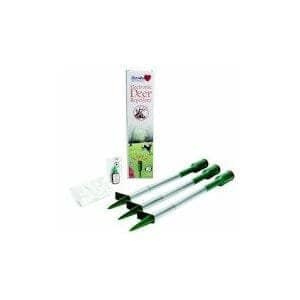Is there really such a thing as a deer proof electric fence? Yes, if you chose the right fencing and install it properly. Unlike other fencing, the fence itself does not have to provide a strong barrier. The electric shock that results from the deer touching it acts as a strong psychological barrier, not a physical barrier. When the deer receive a shock they aren't hurt and they learn not to touch it pretty quickly.
Like most animals, deer will first touch a fence with their noses. Being moist, the current is conducted to the ground, the circuit is completed and the deer receives a shock. There are advantages and disadvantages to electric fencing.
Advantages
One advantage is that it is lighter and cheaper and can be assembled and disassembled easier and faster. When properly constructed there is less chance of deer breaking through. Also, electric fencing may be an alternative where the height of conventional deer fencing might present an eyesore.
Disadvantages
The main disadvantage would have to be that it could not be used were children or pets will be present. Other disadvantages include needing frequent maintenance to keep it is working order. Electric fencing will not function through thick vegetation, so the perimeter must be maintained to keep vegetation under control.
Spraying under the wire with a non-selective herbicide may be necessary. Another disadvantage is that deer, unlike cows, have not been trained to respect an electric fence and they may rush and break through the fence doing damage not expecting a shock.
Of course, deer will not receive a shock if they jump the fence. With all electric fencing, it is a good idea to mark the wire with cloth strips, reflective tapes, aluminum foil or something similar so that the deer notice the fence. Be careful that whatever you use does not hinder the flow of electricity through the fence. Putting bait such as peanut butter on the cloth strips or foil will encourage the deer to put their noses on the fence and be shocked.
Deer normally will attempt to go under or through fencing rather than jump over it. A vertical fence should have wires located 15 inches and again 30 inches off the ground. A 3 wire fence would have wires at 10,20, and 30 inches. If you are trying to protect a vegetable garden and have small animal problems also, start your wire at 3 inches and again at 6 inches.
Wireless Deer Fence
The Wireless Deer Fence is an inventive variation on this type of deer proof electric fencing. The system doesn't use fencing as such, but uses posts that are baited with scented pellets. Deer are attracted to these posts and receive a mild shock, discouraging them from approaching the area in the future. Baited posts are positioned on deer paths, around vulnerable plants, or around special areas like gardens.
This amazing product is safe and will not permanently harm the deer; it sends a small shock that startles the deer. Best of all, it is wireless and will not affect the scenery. It uses a very low dosage of electricity (less than that of getting shocked by static electricity) and deer's natural habits to train them.
If a deer is hurt in a certain area, it remembers and will not return to that area. This silent wireless fence has scent tubes, which not only lead the animal to the training post; in addition, the deer will also remember the scent that led to the shock on its nose. Also, the other deer in the herd are less likely to enter the area that another deer is afraid of. It does have shock warning tops on the posts for additional human safety. But rest assured, it was invented by a veterinarian and will not truly harm the deer. Continuous and repeated shock is not possible because the posts recharge themselves every 11-12 minutes.
The posts require batteries that should last a year if good batteries are purchased. They are lightweight and easy to position. Unlike traditional posts, they can easily be moved.
The wireless deer fence is priced at a very affordable and has an astounding two year money back guarantee. Each set includes three wireless fence posts and a one year supply of the scent. Standard shipping in the U.S. and Canada is free. You can order on line, through the mail, or over the phone. Think of the time and money save by keeping your yard free from the deer and having the convenience of an effective wireless fence.
Temporary Electric Fencing
Temporary electric fencing can be used to protect newly planted landscapes or seasonal gardens. Various strategies may be used for temporary electric fencing, but they may not be 100% effective against all deer species. Deer species vary in they susceptibility.
Red deer seem to be the most susceptible, with roe deer being the least susceptible and white-tail deer falling somewhere in between. One design that has proven effective is a system that has three lines of high visibility electric tape and stands 3 foot in height.
Other systems use 7 stands of wire on a 117 cm post, and 9 wire strands on a 137 cm post. These systems are based on the deer receiving a effective severe shock on their first encounter so that they do not make another attempt to enter. In many cases, if you are having to construct a multi-strand electric fence, you would be better off to use wire or plastic netting or another type of fencing that can be removed at a later date.
Semi-Permanent Electric Fencing
A semi-permanent electric system could consist of a single wire three foot high, and placed four foot from a non-electric fence that is four foot high. The non-electric fence could be made of wire or mesh netting. A single electric wire should be located on the side that the deer would be entering from.
Permanent Electric Fencing
Permanent electric fencing of boundaries and fields is probably best for commercial applications. This type of electric fencing should be constructed of triple-galvanized, high-tensile, 13.5-gauge wire carrying a current of 35 milliamps and 3,000 to 4,500 volts. Several configurations of electric fences are used: vertical strands from one to five, seven or even nine wires.
Slanted wire fences, typically with seven wires are also used. For a low cost system that has had proven success, try a seven strand, five foot high slanted fence. Used in Virginia at a strawberry farm there, they have had 100% control. The 3-dimensional effect of the slanting tier of wires confuses the deer and they are afraid of being entangled.
Combined Electric and Conventional Fencing
There are several advantages to combining electric fencing with conventional fencing. An electric "scare" wire can added to a conventional already existing fence. This adds the shock value without having to put up another fence.
Adding an electric wire will increase the life of the existing fence by keeping the deer from leaning or rubbing on the fence. Combined with high tensile netting, or woven wire fencing are made more effective by combining them with electric wire.
Electic Fence Tips and Tricks
To be most effective, deer fencing should be installed correctly and maintained regularly. Here are some tips on how to build an effective deer fencing:
Make sure the fencing is tall enough: A fencing that is at least 8 feet tall is typically recommended to prevent deer from jumping over it.
Use a fence tensioner: Use a fence tensioner to keep the fencing tight and prevent deer from pushing through.
Electric fencing is a type of fencing that uses an electric current to discourage deer from approaching. It is typically used in addition to another type of fencing, such as mesh or solid fencing, as it may not be enough on its own. Here is an overview of the type of electric fencing that is used for deer control, and how it should be set up:
Type of electric fencing: The most common type of electric fencing used for deer control is made of poly tape, poly rope, or metal wire. The electric current is delivered through these conductive materials.
Energizer: The electric current is generated by an energizer, which can be powered by batteries, solar, or mains power.
Grounding: Electric fencing must be properly grounded to be effective. This involves connecting the fencing to a ground rod, which is driven into the soil. Ground rods provide a path for the electric current to flow through.
Height: Electric fencing for deer control is typically installed at a height of 7-8 feet. This is high enough to deter deer from jumping over it.
Tension: Electric fencing must be kept tight to be effective. Use a fence tensioner to keep the fencing tight and prevent deer from pushing through.
Insulators: Insulators are used to attach the fencing to the posts and keep the electric current from flowing through the posts.
Alarm: Some electric fencing for deer control comes with an alarm that sounds when the fencing is touched, this can be an additional deterrent.
Maintenance: Electric fencing should be checked regularly for damage, and the energizer should be tested to ensure it is working properly.
When setting up the electric fencing it is important to remember that electric fencing is not a physical barrier, it is designed to create an unpleasant sensation to the animal that comes into contact with it. It's main goal is to deter deer from approaching the fencing, and not to contain them. It can be a useful addition to a physical barrier like mesh or solid fencing, but it should not be used as the sole method of deer control.
Use a gate: Install a gate in the fencing to allow for easy access to the enclosed area.
Add an overhang: An overhang of 2-3 feet above the fencing will prevent deer from jumping over it.
Add a visual barrier: A visual barrier such as a row of bushes or trees can help deter deer from approaching the fencing.
Maintain regularly: Check the fencing regularly for damage and repair or replace any damaged sections.
Installing Electric Fence Video
The video below is very detailed instruction on how to set up an electric deer fence that will confuse the deer and keep them out.


